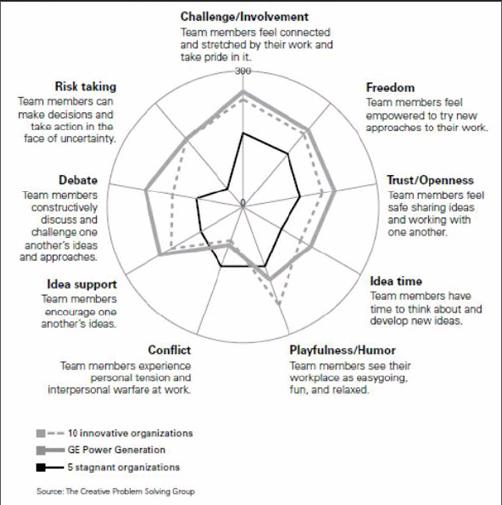General Electric’s Innovation
2017-03-23严岩
严岩

(格上理財成都分公司)
Abstract:Now there is no one doubt the importance of the innovation contributing to a companys development. This article is based on the General Electric Case, analyses its culture and organizational frame, and demonstrate how the company built a innovation-friendly company culture and how innovation makes the company better.
Key words: organization structure, culture, innovation
Attributions of an Innovative Organization
There is no doubt that truly radical innovation has been playing a critical role for companies to compete in the global economy. The very successful MNEs are usually found to be those which value innovation most. General Electric, the American MNE which employing 300,000 people across 100 countries and generating $150 billion dollars in revenue, has a long-standing reputation of being innovative. The following chart gives us a quick view of GEs capabilities to innovate by comparing the average score of the GE Power Generation team with the average scores of 10 innovative organizations and five stagnant organizations. It clearly shows that GE outperformed other companies in terms of the capabilities of innovation.
Innovation cannot occur without real corporate commitment. An innovative organization is usually backed up with a consistent innovative corporate culture. A firms attitudes and practices are the most significant factors in fostering a creative corporate culture in which truly innovative new products, services, and processes can be developed. It indicates that to foster such a culture, not only needs tangible support for R&D, but also requires management to have the right mindset and put the right practices in place. That is to say, executives should have a long-term oriented to trade off current profits generating from investments in maximizing a firms present technology in order to create new generations of technology. GE is a good example that the success of a company is deriving from its consistent commitment to innovation and making sustainable large investments in R&D.
The Innovative Culture of General Electric
Founded in 1878, General Electric was under its way to provide people a modern and convenient life by its innovative products. From more than a century, GE has been seen as one of the most successful multinational enterprises all over the world, admired for its products, culture, and series of strong chief executive. The innovative corporate spirit is one of the most important factors to contribute to the decades of success in GE. From the first practical bubble light to the recent Ecomagination (GE's commitment to imagine and build innovative solutions to today's environmental challenges while driving economic growth), the consistent innovation strategy always plays a key role in the development of the company. The cornerstone of GEs success is the continuous pursuing for innovation which was made possible by large amounts of investment into R&D department no matter in good or bad time. The innovative culture of GE can be expressed in the highly consideration of innovation. Throughout GEs developing history, every CEO put an emphasis on the value of innovation. The CEOs efforts on pushing the innovation strategy not only limited in allocating funding, but also devoted themselves into the development of new products, services, and processes in all kinds of ways.
The first CEO of the company was Charles Coffin, who ran the company until 1922. Under his charge, GE achieved rapid growth through fast-paced invention. In 1900, Coffin established the first R&D lab. One of the labs tasks was to defend the market of incandescent lighting through the continuous innovation. As a result, the development of the ductile tungsten filament enhanced GEs position of a technology leader in the lighting market by extending the product life time. Under the leadership of Coffin, GE adopted a differentiated production strategy to meet the novel conditions. Therefore, R&D became essential to leverage core technologies and to create new business in the different fields because the research drove innovations was fundamental to every field the company wanted to explore. It was the first time that GE brought the product innovation strategy into the company which led to the best sales in the history. In 1913, the sale record was nearly $106 million. In return, the successful performance made a strong investment in R&D possible which enhanced the innovation strategy.
Another thing contributed to GEs innovation was the premium attention it paid to its employees suggestions. In 1922, GE launched a suggestion system to simulate the initiative of employees and to collect suggestions for better way of doing things regarding products, services, and process from a large number of employees all over its global operations. The suggestion system had induced 29,919 suggestions and more than 32 percent of suggestions were adopted to improve the corporate performance. Thanks to the noticeable improvement of the production processes and methods, GE was able to reduce the selling price of existing products.
The GEs innovation culture could also be seen from its consistent investment in R&D even in the bad economic time. To be able to financially support its R&D, in 1932, GE created the GE Credit Corporation which helped finance the sale of the companys appliances. In this way, the company managed to invest into R&D even during the Great Depression.
After the World War Two, GE opened up a new organizational vision by changing its long-term product strategy used since 1900. It adopted a diversification strategy by selling different products and services in the global market. Because the efficiencies of the companys R&D, GE could have the possibilities to sell products at lower cost with reasonable profits compared to other competitors in the world market. In the 1950s, GE started to consider selling a combined system of products and services, instead of physical products, to fulfill specific customer demand by leveraging its manufacturing expertise. Due to the major emphasis of accelerating growth in service businesses, the product service became a growing worldwide business for GE and services revenues generated 16 percent of GEs earning by 1979. In 1980, the technology innovation was a driving force to every possible product, service, and process in GE.
In 1990s, under the leadership of Jack Welch, GE achieved a further success and break new ground. Instead of using a product innovation strategy, Welch thought that acquisition and alliance were the origin of innovation. Influenced by Welch, GE was heavily focused on services and became a global service company that also sold high quality products. In 2000, 70 percent of GEs business was derived from services. To create a more suitable organizational environment for innovation and to respond more swiftly to intensive competition in the global market, Welch noted that it was necessary to change the organizational structure of bureaucracy and cut down the unnecessary paper works. One of his first changes was to initiate a strategy formulation process with the guideline that each of the businesses should be Number one or two in their respective areas. If this was not the case, managers had the options of fixing the problem, selling their particular business, or closing it. In an effort to streamline the organization, Welch removed the sector level and eliminated thousands salaried and hourly employee positions. The restructuring was followed by changing the organization culture and managerial style of GEs managers. One such program was the Work-Out. Group of managers were assembled to share their views openly in three-day sessions. Another program to improve effectiveness and efficiency was Best Practices. The aim was to learn from other companies how they obtained customer satisfaction, how they related to their suppliers and in what ways they developed new products. This helped the GE people to focus on the processes in their operations that would improve the company performance.
The current CEO, Jeffrey Immelt, inheriting the GEs tradition of innovative culture, continued to make a huge investment in R&D. About $16 billion which was amounting to near 6 percent of the companys industrial revenues was giving to R&D between 2010 and 2012. In 2005, GE launched an Ecomagination campaign, which commits to “imagine and build innovative solutions to today's environmental challenges while driving economic growth.” Since the program began, GE had invested $5 billion in the R&D by the end of 2009, and planned to continue investing $10 billion over the next five years. The technology and products resulted from this program had generated $70 billion in revenue from 2005 to 2010. Since 2007, this program had gained a considerable profit. In 2010, the Global Innovation Barometer was created for exploring the influence of innovation on business strategy in the increasingly competitive worldwide markets. The Barometer is an international opinion survey of senior business executive actively engaged in the management of their firms innovation strategies. It is the largest global survey of business executives dedicated to innovation.
The Problem in GE
We can draw a conclusion that GE has a tradition of innovation based on GEs large investments of R&D and leaders continual efforts to stimulate innovation throughout its history. The recent underperformance of GE is not caused by the absence of innovative spirit, but caused by the unchanged organizational structure since Jack Welch. The unavoidable bureaucracy due to the high level of formalization and standardization in the bulky organization leads to insensitive responses to rapid changing environment. Hence, the capabilities of a colossal company to innovate are decreased. Besides, the legacy of Jack Welchs management may impede the company to change the organization structure and the existing management style in order to adjust to the changes of times. Therefore, the problem GE faces today is not the lack of an innovative culture, but the inconformity between its management structure and the innovation strategy.
References
[1] Heath Downie, & Adela J. McMurray. (2012, Nov. 19) The Evolution of GEs Product Innovation Strategy. Proceedings of the 19th International Business Research Conference. Retreived from http://papers.ssrn.com/sol3/papers.cfm?abstract_id=2178230.
[2] Candace Lombardi. (2010, June 24) GE to invest $10 billion in Ecomagination initiative. Retrieved from http://news.cnet.com/8301-11128_3-20008698-54.html.
[3] Retrieved from http://www.ecomagination.com/.
[4] Steve Denning. (2011, Mar. 1) Don't Blame Green For GE's Problems. Forbes. Retrived from http://www.forbes.com/sites/stevedenning/2T011/03/01/dont-blame-green-for-ges-problems/.
[5] David C.Wyld, & Robert Maurin. Keys to Innovation: The right Measures and the Right Culture? Retrieved from http://faculty.london.edu/rchandy/summ.pdf.
